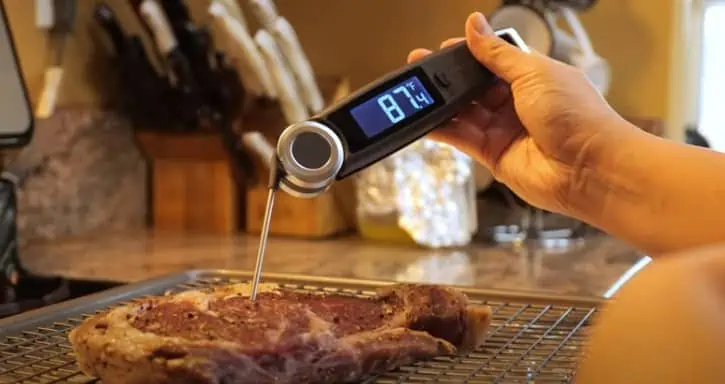How to Sanitize Meat Thermometer: Terrific Tips for Barbecue Enthusiasts
Written By James Morgan
Every barbecue enthusiast knows that ensuring the safety and flavor of their grilled meats begins with precise temperature readings. However, what often gets overlooked is the importance of keeping your meat thermometer sanitized. Not only does this practice prevent cross-contamination, but it also ensures the longevity and accuracy of your thermometer. Here's an in-depth guide on how to sanitize meat thermometer with both common and life-changing methods.

Why is Sanitizing Your Meat Thermometer Important?
When it comes to food safety, keeping your meat thermometer clean is paramount. Bacteria can easily transfer from raw meat to cooked food if a contaminated thermometer is used. Not only can this mess with the flavors of your meat, but it also poses health risks such as foodborne illnesses.
According to the Old Farmer's Almanac, using a clean meat thermometer is one of the simplest ways to ensure your barbecued meats are safe to eat. Let's explore why it's essential and how you can incorporate this habit into your grilling routine.
:max_bytes(150000):strip_icc()/ses-meat-thermometers-test-temp-spike-rkilgore-17-c32b7edc988045f69c7d11bb2d8080d5.jpeg)
Materials You'll Need
Basic Cleaning Supplies
- Anti-bacterial dish soap
- Hot water
- Sponges or soft brushes
- Clean cloths or paper towels
Advanced Sanitizing Supplies
- Isopropyl alcohol (70% or higher)
- Food-grade sanitizing solution
- Disposable gloves for handling chemicals

Step-by-Step Guide to Sanitizing Your Meat Thermometer
Initial Rinse
Start by rinsing the thermometer under hot running water to remove any surface residue. Avoid using extremely hot water as it may damage some digital thermometers.
Scrubbing and Cleaning
Apply anti-bacterial dish soap to a soft brush or sponge and scrub the thermometer thoroughly, especially around the probe and handle. Ensure you reach all the nooks and crannies where bacteria might hide.
Rinse Again
Rinse the thermometer once more under hot water to remove soap residue. Make sure all soap is eradicated to avoid any chemical contamination.

Advanced Sanitizing Techniques
Using Isopropyl Alcohol
Dip a cloth in isopropyl alcohol (70% or higher) and wipe down the entire thermometer. Alcohol kills bacteria and evaporates quickly, making it a practical deep-cleaning solution.
Food-Grade Sanitizing Solutions
For those more serious about sanitization, consider using a food-grade sanitizing solution. Follow the manufacturer's instructions for the correct dilution and application methods. This is particularly important for those who frequently barbecue and want to keep their equipment in pristine condition.
When to Sanitize Your Meat Thermometer
Ideally, you should sanitize your meat thermometer:
- Before and after every use
- After measuring different types of meat
- If the thermometer has been dropped or contaminated in any way
Common Mistakes to Avoid
Letting it Sit Too Long
One of the most common mistakes is letting the thermometer sit with food residue for too long before cleaning. Bacteria can multiply rapidly, making it more challenging to sanitize effectively.
Using Harsh Chemicals
Avoid using harsh chemicals like bleach, as they can damage both the thermometer and potentially contaminate your food. Stick to food-safe cleaning solutions.
Pro Tips for Maintaining Your Meat Thermometer
Regular Calibration
Regularly calibrating your meat thermometer ensures its accuracy. Some advanced models come with auto-calibration features, but manual calibration is usually straightforward as well.
Proper Storage
Store your meat thermometer in a clean, dry place. Some thermometers come with protective cases, which are ideal for preventing damage and contamination.
FAQ
How often should I sanitize my meat thermometer?
Ideally, you should sanitize your meat thermometer before and after every use to ensure food safety.
Can I use bleach to sanitize my meat thermometer?
Its not recommended to use bleach as it can be harsh on your thermometer and may contaminate your food. Stick to food-safe sanitizing solutions.
What is the quickest way to sanitize a meat thermometer?
The quickest way is to use a cloth dipped in isopropyl alcohol to wipe down the thermometer. This method kills bacteria and evaporates quickly.
For more information on how to properly use a meat thermometer, check out these helpful articles on where to put meat thermometer in tri-tip, how to use a metal meat thermometer, and where to put meat thermometer in duck.
As an Amazon Associate, I earn from qualifying purchases.
As an Amazon Associate, I earn from qualifying purchases.



